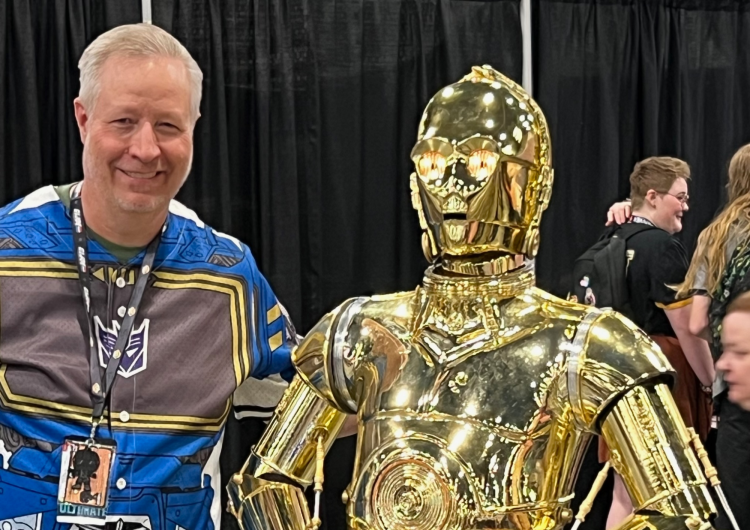‘Fly Me to the Moon’: Scholar weighs in on our fascination with conspiracy theories
Banner image: Channing Tatum and Ray Romano in “Fly Me to the Moon.” (Credit: Sony Pictures)
Romcom lovers rejoice: This week, moviegoers can watch the sparks fly between Channing Tatum and Scarlett Johansson in “Fly Me to the Moon,” a chemistry lesson set against the backdrop of the Apollo space program. The film appears Thursday in theaters and on Apple TV+ later this year.
For Rick Stevens, a CU Boulder media scholar who studies, among other topics, pop culture and the challenges of communicating about science, the movie is ripe for discussion. “Fly Me to the Moon” pits Tatum, a fictional and buttoned-down NASA director in the 1960s, against Johansson, a PR maven who’s been hired to “sell the moon.” It also pokes fun at conspiracy theories that have swirled around NASA for decades—one subplot follows Johansson’s efforts to film a fake version of the moon landing, just in case the real one doesn’t work out.
Stevens, an associate professor in the Department of Media Studies and self-described science and science fiction fan, saw “Fly Me to the Moon” during an advanced screening in Denver. He gives his take on what he calls a “wonderfully tense” popcorn flick—and why conspiracy theories around a fake moon landing have persisted more than 50 years later.
[embedded content]
What did you think about ‘Fly Me to the Moon’ on your first watch?
The film is very effective, first of all, at returning the viewer to the heightened anxiety of that time. Today, we forget how much anxiety there was around the Cold War, around the Nixon administration around the Vietnam War, the counterculture movement, Civil Rights Movement, all of that.
It also captures the excitement of that time. Every time you see an Atlas rocket take off, the theater shakes.
What does the movie say about the challenges of communicating about science?
It does a great job getting the cultural conversations on the ground—thinking about this dual framework of NASA being an organization dedicated, of course, to science and putting people in environments where they hadn’t been before.
At the same time, NASA has to hire PR firms to try to get the public to understand and get excited about science. For some of the characters, their job is to “sell the moon”: Why did Apollo matter? Why should we be excited?
How do the science-type characters react to that?
You see the resistance. That’s what the film is ultimately about—the tension around engineers who take as given that their mission is going to be understood as good, and not liking the way their realities were being spun. That church and state separation between the public and the private sector is discussed quite a bit throughout the film. But NASA embraces that PR dark side, as it were, over and over. It’s wonderfully tense.
Let’s get to conspiracy theories. Where did the idea that the moon landing was faked come from?
That conspiracy theory comes about mainly in the early ’70s. Richard Slotkin, who’s a sociologist, talks about the “paranoid style” of politics in that era. It’s after Watergate, after the Pentagon Papers and after all of these revelations that the military, the government and even, at times, members of the media have not necessarily been giving an accurate version of events. It creates a space for conspiracy theories to flourish.
Why does this conspiracy theory have such staying power?
Part of my research is thinking about those moments when there’s a big shock to the system. The moon landing, the Challenger disaster, 9/11—all of these are events when our normal routines were disrupted, and it leaves people searching for meaning.
Media outlets are not designed to give people reassurance and meaning. They’re trying to produce a record of events based on documented statements and images. The difference between those logics creates this fertile ground for certain people who have reasons to mistrust institutions to spin all kinds of fanciful theories.
Do you think there’s a danger of giving credence to the conspiracy, even if it’s tongue-in-cheek?
I imagine when this film hits theaters and Apple TV+, Google searches for “is this film real?” are going to trend. There was a little part of me that thought, going into the theater, “Am I okay with Apple putting it out there as a possibility?” But every year somewhere between 5% and 10% of Americans believe the moon landing was faked. And that’s without any evidence or NASA giving any shred of confirmation.
So you’re saying the conspiracy is already out there, might as well joke about it?
Characters in the film go to extraordinary lengths to reproduce the moon on a soundstage. It makes it seem very unlikely that such a thing could have actually happened, especially without someone noticing. I think that avoiding this space is more damaging than getting into, exploring it, having a little fun with it, and then pointing out it would be ridiculous to think that the moon landing could have been faked.
Ultimately, what does the film say about NASA and science at the time?
The film shows through dialogue and character interactions that NASA is caught. It’s caught with PR it doesn’t want to do and caught with the Nixon administration and its goals. NASA becomes the ultimate “we’re going to solve this problem” force, which is really a strong pro-science statement.
CU Boulder Today regularly publishes Q&As with our faculty members weighing in on news topics through the lens of their scholarly expertise and research/creative work. The responses here reflect the knowledge and interpretations of the expert and should not be considered the university position on the issue. All publication content is subject to edits for clarity, brevity and university style guidelines.



